Getting mystical in Tuscany and Umbria
To find out what lies beyond the tourist hotspots
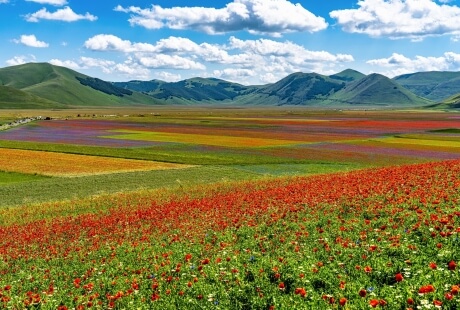
Italian escapes are all about indulging in delicious food and wine, exploring proud local cultures, discovering towns perched on a hilltop and their layers of history that may belong to a fairy-tale book. Beyond memorable landscapes and priceless artworks, however, mystical places are found across the country: sometimes bizarre, surreal locations where the genius of learned souls created baffling, mysterious masterpieces in search of an interpretation, or offering space for the soul and the mind, in a gentle search for the ultimate wellbeing. We have come to attractive Umbria, the heart of Italy, and neighbouring gorgeous Tuscany to find out what lies beyond the tourist hotspots.
It may be a small region, but Umbria boasts a variety of landscapes, views and terrains that is almost unmatched across the country. From the high peaks in the Apennines to the sweet shores of Lake Trasimeno, fields decorated with olive groves to wild forests, the region excels in superlatives and all the quintessential qualities that make Italy always a dream destination: passion for authentic traditions, a slower pace of life, immense artworks and the will to protect the natural heritage. We are on a hunt for riveting, unusual places across the region
Like Umbria, neighbouring Tuscany is a dear friend to anyone seeking delightful vistas, rolling hills dotted with vineyards, medieval towns coming alive with jousts and festivals, with the added charm of unique art cities. A region with a thousand facets, this is where you will also find mysterious, mystical places where the magical and natural meet to create unusual experience

1. The abbey of Saint Benedict at Subasio
Perhaps the most famous saint in the world, the history of Saint Francis, featuring his will to return to a humble life and his love for mother nature, still resonates strongly to this day. His birthplace, Assisi, attracts pilgrims from far and wide, and its mystical atmosphere is enhanced by the presence of Mount Subasio. Modest in height (1,290 m / 4,230 ft), this mountain has always been associated with spirituality and several communities favoured its silence and serene atmosphere that favours meditation. Close to Assisi, the Abbey of Saint Benedict was founded in the 11th c. and this is where Saint Francis came to ask for a place of worship in 1210. The then abbot allowed the friar to have the small chapel of the Porziuncola, now kept in the church of Saint Mary of the Angels.
The abbey can be visited and its bare interiors make it a place of profound worship: the crypt that rests on three columns and the wider, cross-shaped crypt hint at a feeling of mysticism and sobriety, offering respite and a refreshing feeling of peace that lingers on well after you have left.
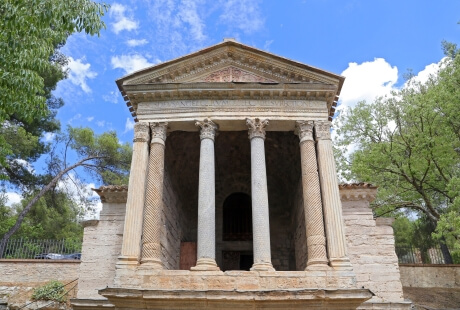
2. Inspiring poets: the Clitunno river
Several rivers dot the entire Umbrian region, clear waters stemming from them, adding life and colour to the landscape. Sung by Pliny and Virgil, the small Clitunno river was loved by the Romans, who used it as a connection with the eternal city and had several small temples built along its shores. After an alleged earthquake in the 5th c., the riverbed changed its shape and became smaller, but the fascination remained unaltered.
The English poet Lord Byron sung its beauty in his Harold’s Pilgrimage poem, while the Italian poet Giosuè Carducci penned an ode describing its pure waters and their magical aura, after visiting neighbouring Spoleto. Powered by underground springs, the river is part of a delightful natural park that features various ponds and is surrounded by a rich fauna including swans, birds and ducks, as well as many species of flowers. Visit the Paleochristian temple of Clitunno, close to the spring: the small chapel displays remains of frescoes and its mystical vibes will have you in awe.
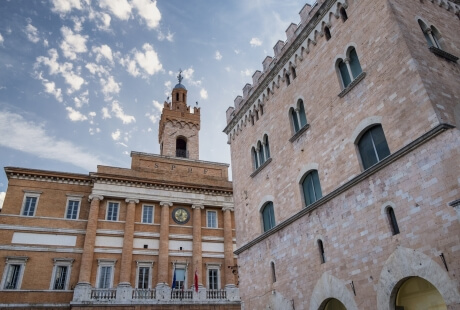
3. When planets align - Palazzo Trinci
Finding time to admire artworks is soul-enriching and enhances our culture, artists trying to express their feelings and the viewer engaged in an inner conversation that increases our wisdom. Contemplating works from the early Quattrocento means coming up close with the century that sought to find harmony and balance in human knowledge by adding scientific research. This exploration is perfectly exemplified in Palazzo Trinci, the extraordinary palace in the centre of Foligno.
This cultural powerhouse entails an art gallery, an archaeological museum and an interactive museum of jousting and tournaments: inside, the frescoes by Gentile da Fabriano offer an insight into the meaning of the seven (then known) planets depicted – the Moon, Mars, Mercury, Jupiter, Venus, Saturn and the Sun. It’s not only horoscopes and faux myths, for the planets do have an influence on our lives, and to see them explained in such detail in the sublime works by this pivotal renaissance artist is truly impressive. Add the overall experience of visiting this incredible palace – Escher would love the setting – where several buildings have been merged into a single one across the centuries and the many stairs, rooms, floors and decorations make us feel humble in front of such a potent display of knowledge
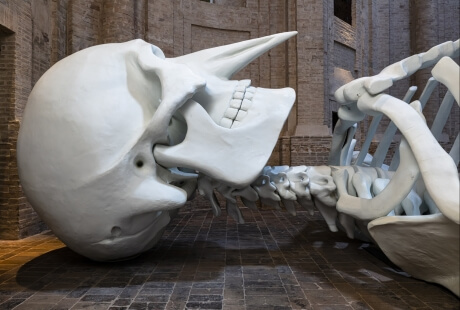
4. An alien skeleton – the Calamita Cosmica
Churches contain works of various shapes and eras, their architecture reflecting the taste, knowledge and art trend of a specific time, but they rarely contain such imposing artworks as the Calamita Cosmica, a 24-metre long skeleton that adorns the bare church of Santissima Trinitá in Foligno. Its dimensions itself hint at an alien invasion, with the nose of the figure clearly the beak of a bird, adding mystery to this figure. The installation is the work of the artist Gino de Dominicis, executed at the end of the 1980s and shown in several places such as Versailles, the Royal Palace of Capodimonte, Rome and Brussels over the decades. The long metal shaft placed alongside it points towards the dome of the church and well beyond, symbolising the union of man and the universe. Carried out with iron, polystyrene and fiberglass, the late artist originally wanted to cover the bones of the skeleton with gold leaf; this idea only remained a wish that was never fulfilled, but the aura of this immense, intriguing and peculiar work still impresses visitors, ready to ask questions on our role in life.

5. The ideal city of Scarzuola
Saint Francis returns again and again in Umbria, his presence felt at every corner. His connection to the Scarzuola, the eclectic ideal city erected by the genius of Tommaso Buzzi, a visionary designer and architect and art collector, strikes a chord as an evocative place. This is, in fact, the place where Saint Francis had his convent erected in 1218, its name stemming from scarza, a marsh plant initially used by the saint to erect the building. After years of abandon, the eclectic Buzzi acquired it in the 1950s and chose to create an ideal city, a metaphor of theatre and the folly of human life.
Seven theatres were built with lava stone, some of them clearly visible, while others have been eroded over time: the inspiration may have come from learned texts such as the 1499 Hypnerotomachia Poliphili by Francesco Colonna, and the overall sense of magic and mystery live alongside in a surreal display of empty stages – a hint to the ideal representation of our lives? Whatever interpretation you may give to this surreal location, witnessing how buildings change over time and what personalities lie behind them is a cultural journey that sees no end

6.The Devil’s bridge
The Devil’s bridge - Dating back to the Middle Ages, Ponte della Maddalena is a bridge in Borgo a Mozzano, close to Lucca, on the river Serchio. Its half-diamond shape may have been common at the time, but its asymmetric arcades were not, making it really special, its height seemingly defying gravity. The place is also known as Devil’s bridge in view of the legend that surrounds it: one of the people in charge of building the bridge realized time was not enough to complete the work for the fixed date, so he asked the Devil for help. The latter agreed to complete it in one night and asked for the man’s soul in return. When it came to handing himself to Lucifer, the man had a pig cross the bridge for the first time; that way, the Devil was taken in and disappeared, never to return.
The bridge and its peculiar shape have stood the test of times and it is your turn to walk on it and admire the views stretching onto the verdant surroundings.
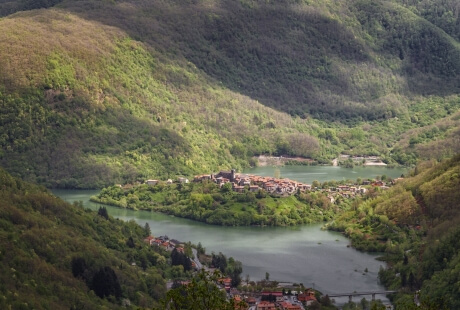
7. A ghost town under Lake Vagli
Think of a picturesque lake surrounded by the Apuan Alps in the northern Garfagnana area of Tuscany. You may enjoy the views from the shores of Lake Vagli, swim in its waters (Vaiano is the only place where this is allowed), get your adrenaline fix on the zip-line or spend time fishing in a dedicated area.
Most certainly you will not suspect, however, that an entire ghost town is buried on the bottom of the lake. The hamlet of Fabbriche di Careggine was submerged after an artificial lake was formed from the river Edron and a dam was created in 1947. The inhabitants were moved to another village and the ancient medieval town only remerges when the lake is drained for maintenance work. Since its construction, this has only happened four times, in 1958, 1974, 1983 and 1984. Watch this space as its opening may happen in the coming years! People from all over the world will come and see what a proper ghost town, including a church and its bell tower, look like after so many years spent underwater. Atlantis, move on!
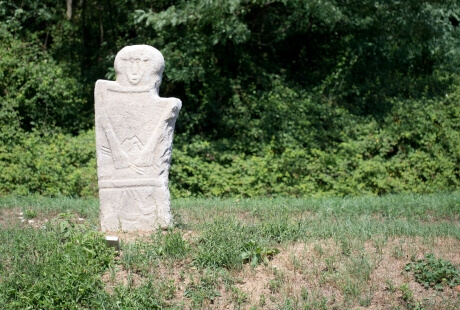
8. Reinterpreting the past - the Stele statues in Lunigiana
Tuscany is replete with museums and artworks abound, each small town a jewel in its own right. It is also a region where connections with the past are strong and feel very tangible. Come to the Stele Statue Museum in Pontremoli, in northern Tuscany, for an outstanding experience. Dating back to several millennia, the first sandstone stele was found in Val di Vara in 1827, with others swiftly following.
These anthropomorphic statues supply pivotal information on the culture and religion of the Bronze and Iron Ages in the area. What emerges is a complex world, where exchanges with other cultures were frequent and this becomes clear from the several types of sculptures. Explore the museum and learn about the fascinating, enigmatic history behind each and every artwork, from the minimal details adorning apparently bare figures to more ornate depictions, with the certainly that you are looking at a precious tool to decipher the history of humankind.
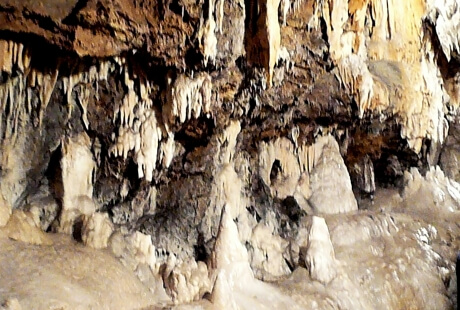
9. The world beneath – exploring caves
One of the most complete caves in Europe, the Grotta del Vento (the wind cave) is located in Fabbriche di Vergemoli, by Lucca and counts as an unmissable experience. Do not expect your average cave with a few stalagmites and humidity in droves: this peculiar jewel in the Apuan Alps counts as a true adventure within a splendid natural park. The rock comes alive with the water running through the various concretions, making every shape smooth and shiny; choose up to three different itineraries that take you deep within the core of this marvel of nature, discovering the power of concretions, how water changed the appearances of these mysterious locations and how the world of the abyss can be fascinating. The entire area is replete with sites where the karst phenomena left a mark, such as Monte Foratoor the lunar landscape of the Vetricia plain. Come and discover a hidden part of Tuscany

10. Three slow food presidia in Lunigiana
Any trip to the Belpaese must include indulging in local delicacies, the attention for genuine, authentic ingredients at the core of Italian cuisine. Lunigiana, in northern Tuscany, reveals its aura when it comes to its delicious products, such as chestnut flour, the Lamb of Zeri and the testaroli of Pontremoli. All of them sporting the Slow Food label, the simple, yet delicious local cuisine is hard to beat. Testaroli are a special type of pasta prepared by using the testi, two iron plates where a batter of flour, water and salt are poured to obtain the delicious pasta, cut into diamond shapes and served with oil and cheese.
Casola di Lunigiana is where you’ll find the delicious chestnut bread. Chestnut flour was originally the only one available in the area, hence the creation of this special bread, originally mixed with potatoes to add a spongy feel. Only one oven in Casola cooks it and it is the perfect companion to cured meats, cheese and the special Lardo di Colonnata!
Come to Zeri to taste the lamb coming from a unique breed of sheep, where the animals roam free in special bucolic surroundings. The lambs are cooked on an open fire and placed between the same iron testi used for the pasta dish.
This is delicious indeed!
Travel Tips where to stay
Il Bottaccio Boutique Art Hotel - Tuscany
Ask for more info about the best experiences and itinereraries we can design in Tuscany
marketing@claudiadarin.it
All contents, photos and texts are subject to copyright. They are only authorised on my website and social media. Ideas can be a source of inspiration, but any unauthorised use of images and texts is strictly forbidden. All rights reserved.




